October 24, 1786. Vermont Legislature Grants Harmon an Extension, and Mandates New Designs.
After a year of struggling with the now beloved Landscape coppers, Ruben Harmon had had enough. As a store clerk, he himself felt the difficulty in circulating this somewhat unusual looking coin in a region and era used to a King and a Woman. Also, the combination of design, metal flow and related metal quality, resulted in each and every Landscape did beating itself to death. It was difficult to get the huge contraption of a screw press aligned correctly. Sometimes he got coins with hardly any impression on ins side. Awful stuff. So in the fall of 1786 he petitioned the Legislature ( which met in two 2day sessions, spring and fall), to allow a more conventional design. The law was changed, Harmon granted an extension and a new design specified. The obverse, simply " a head". The reverse, the figure of a woman seated referred to as "the Genius of America". The resultant first Bust issue was the Quaint and Folksy Baby Head. However did they arrive at this design? Collectors have pondered that for centuries. Carlotto advances the theory the die was created by Coley as a commutative of two recent births in Harmon's Family. Some suggest it represents the "Infant Vermont". Clearly it is not a King and the reverse figure is not Britannia. She is mysterious in both appearance and garb. Higher grade examples (few and far between) show an engraved eye, hairdo and facial features. She wears several hoops, wires, lines??? over her shoulder. Four powder horns show her readiness to defend against attack. Four wheat sheaves adorn the shield, and she makes no pretense of empire, the "globe" she is seated on has no latitude and longitude lines. ~~~~~~. They must have been beautiful when the planchet stock was pristine. Mostly all though are "defective" in one way or another, and this is not much of a problem for a Vermont collector. ~~~~~~~. Way back in 1786, on this day, a Baby was Born. 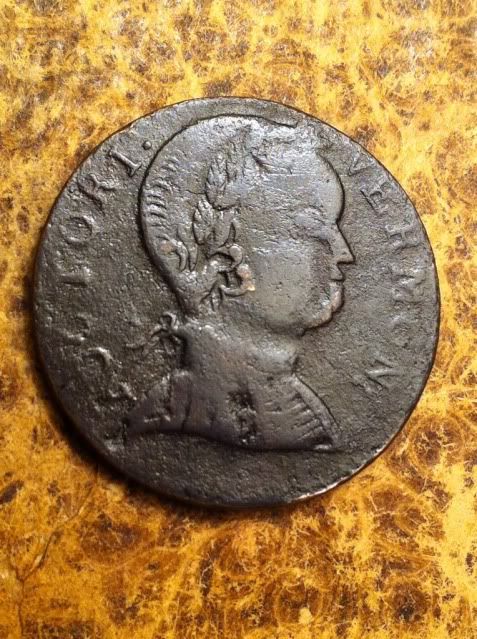 .
.  . Some time later, Harmon decided to change the design, but still worked within the Mandate. Killing two birds with one stone he brought in the answer in the person of William Buell, the 14 year old son of Conneticut die maker Abel Buell. This was not without grief though, as soon into his journey William was accosted by Indians who demanded a drink from the jug of Rum they thought he had. The "Rum" though, was aqua fortis, a deadly acid. The Indians finally got the jug, one guzzled down the liquid and promptly died. This led to a foot chase of miles with William finally arriving safely at Rupert Vermont. His Treasure, the hubs made by Abel Buell himself. Exquisite relief forms of King George II and Britannia, though with a solitary wheat sheaf on the shield. Already dated 1786, they merely needed to be impressed into the unhardend die blank. William, at 14, was the closest thing to a die maker on hand so he took what was left of the punches and put in VERMON AUCTORI and INDE ET LIB in and the men started making coins. Still forced to use melted down cannons, the planchet stock was as miserable as on the Baby Head. The first few coins off ths die had startlingly beautiful feature. George's hair was well defined, the fields were smooth, letters crisp and the shield showed Vermonts heritage well. It didn't last. The die steel was awful. Perhaps not hardened enough after the impression from the hub, and after a few thousand coins the bust lost nearly all it's fine detail. The First Strikes Though......
. Some time later, Harmon decided to change the design, but still worked within the Mandate. Killing two birds with one stone he brought in the answer in the person of William Buell, the 14 year old son of Conneticut die maker Abel Buell. This was not without grief though, as soon into his journey William was accosted by Indians who demanded a drink from the jug of Rum they thought he had. The "Rum" though, was aqua fortis, a deadly acid. The Indians finally got the jug, one guzzled down the liquid and promptly died. This led to a foot chase of miles with William finally arriving safely at Rupert Vermont. His Treasure, the hubs made by Abel Buell himself. Exquisite relief forms of King George II and Britannia, though with a solitary wheat sheaf on the shield. Already dated 1786, they merely needed to be impressed into the unhardend die blank. William, at 14, was the closest thing to a die maker on hand so he took what was left of the punches and put in VERMON AUCTORI and INDE ET LIB in and the men started making coins. Still forced to use melted down cannons, the planchet stock was as miserable as on the Baby Head. The first few coins off ths die had startlingly beautiful feature. George's hair was well defined, the fields were smooth, letters crisp and the shield showed Vermonts heritage well. It didn't last. The die steel was awful. Perhaps not hardened enough after the impression from the hub, and after a few thousand coins the bust lost nearly all it's fine detail. The First Strikes Though...... 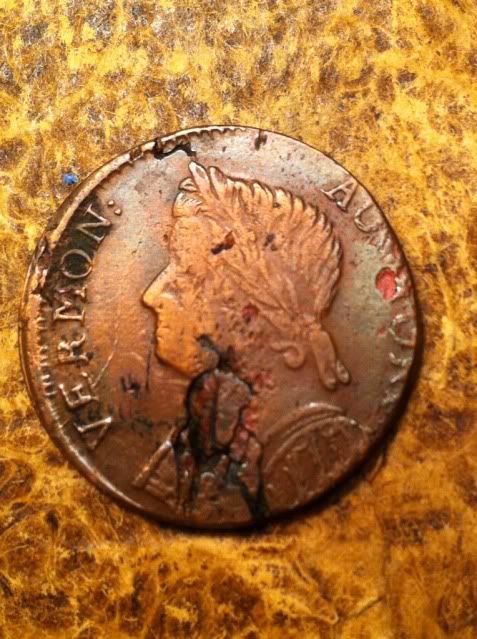 .
. 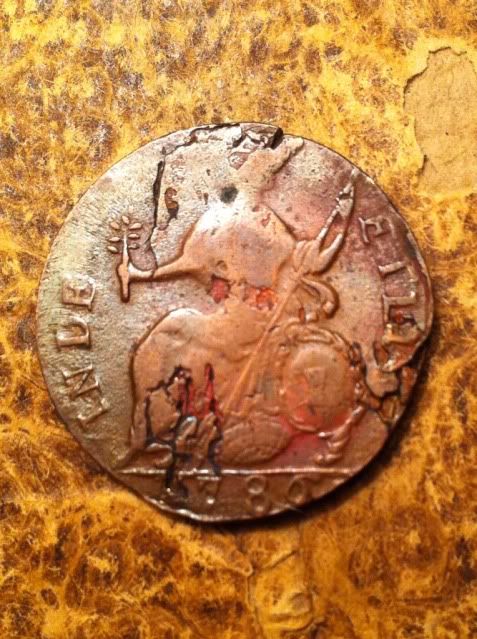 . The coin proved to be a success in circulating. Blending in well with Regal halfpence, imitation halfpence as well as Conneticut coins the due was used until multiple small cracks and general lack of design boldness forced its retirement. But, they had the Hubs...do they made two new dies, with slightly different letter positioning than the first variety. The letter punches were failing, forcing William to strike odd tools and inverted numeral one stamps to make the letters. The result worked pretty good, but many were struck weakly on one side.
. The coin proved to be a success in circulating. Blending in well with Regal halfpence, imitation halfpence as well as Conneticut coins the due was used until multiple small cracks and general lack of design boldness forced its retirement. But, they had the Hubs...do they made two new dies, with slightly different letter positioning than the first variety. The letter punches were failing, forcing William to strike odd tools and inverted numeral one stamps to make the letters. The result worked pretty good, but many were struck weakly on one side.  .
.  As the cold winds began to blow, and the days get short... the New Year of 1787 dawned at the Rupert Mint. The moment had came. The new coin die must be created. Again the Buell hubs are brought out and set into the hulking screw press. The old veteran had now made dozens of dies and thousands of coins. With great force the iron balls were swung around and the die impressed. Now more than ever young William improvised to make the letters. Odd tools became punches and then the next, and most critical operation remained. The Overdate. No doubt this was a moment of gut wrenching angst. Would it work? No one knew. After a long hesitation, Will approached the die, and carefully placed a small "7" stamp above the 6. (you can feel his apprehension, can't you?). Then he brought back his hammer and gave if a tap. Any workman knows after awhile exactly how long of takes something to drop off his workbench and hit the floor. William knew that time too, and as if on cue, a very small piece of metal hit the floor. The die was ruined. Ruined. But being thrifty Yankees they put it in the press and "made some coins". Happy New Year. The result we have today in the twenty extant specimens of the 1787 Vermont Bust Left Ryder 15.
As the cold winds began to blow, and the days get short... the New Year of 1787 dawned at the Rupert Mint. The moment had came. The new coin die must be created. Again the Buell hubs are brought out and set into the hulking screw press. The old veteran had now made dozens of dies and thousands of coins. With great force the iron balls were swung around and the die impressed. Now more than ever young William improvised to make the letters. Odd tools became punches and then the next, and most critical operation remained. The Overdate. No doubt this was a moment of gut wrenching angst. Would it work? No one knew. After a long hesitation, Will approached the die, and carefully placed a small "7" stamp above the 6. (you can feel his apprehension, can't you?). Then he brought back his hammer and gave if a tap. Any workman knows after awhile exactly how long of takes something to drop off his workbench and hit the floor. William knew that time too, and as if on cue, a very small piece of metal hit the floor. The die was ruined. Ruined. But being thrifty Yankees they put it in the press and "made some coins". Happy New Year. The result we have today in the twenty extant specimens of the 1787 Vermont Bust Left Ryder 15.  .
. 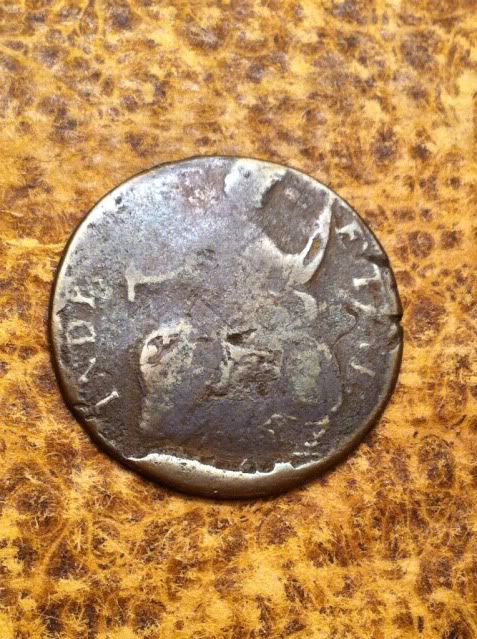 . But Wait! Only the reverse was ruined, so they dusted off the previous reverse, though dated 1786, and made more coins. The debacle though with the failing 1787 die though caused a weakening of the obverse, and cracks developed at about 1oclock on the lettering. Existing coins from this second use show this crack growing, probably leading to a chunk falling out. Still batteling bad metal, these were the last coins struck at the First Mint by an Independant Republic on the North American Continent. And, that's pretty darn good for a wood shack the size of your garage! I hope you enjoyed this story of those talented men and the coins they made. Here's one of their very last, second strike Ryded 11.
. But Wait! Only the reverse was ruined, so they dusted off the previous reverse, though dated 1786, and made more coins. The debacle though with the failing 1787 die though caused a weakening of the obverse, and cracks developed at about 1oclock on the lettering. Existing coins from this second use show this crack growing, probably leading to a chunk falling out. Still batteling bad metal, these were the last coins struck at the First Mint by an Independant Republic on the North American Continent. And, that's pretty darn good for a wood shack the size of your garage! I hope you enjoyed this story of those talented men and the coins they made. Here's one of their very last, second strike Ryded 11. 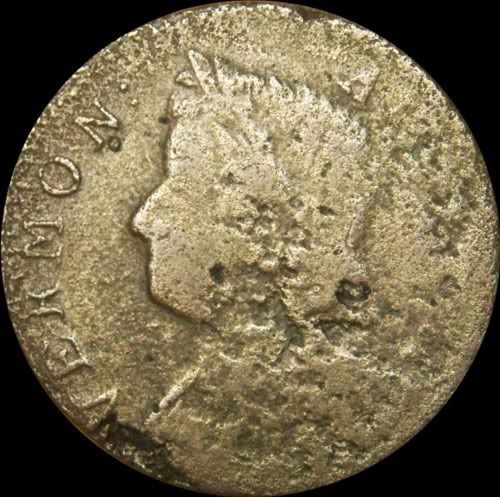
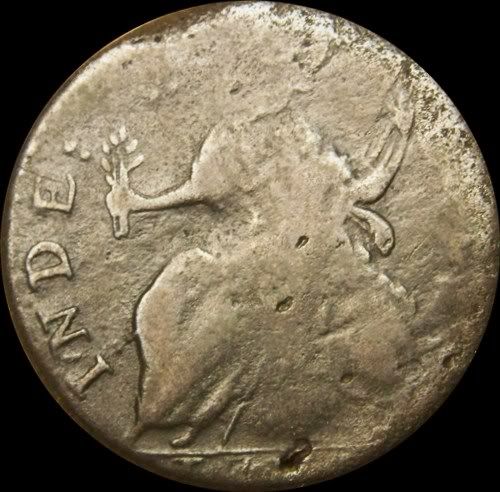
 .
.  . Some time later, Harmon decided to change the design, but still worked within the Mandate. Killing two birds with one stone he brought in the answer in the person of William Buell, the 14 year old son of Conneticut die maker Abel Buell. This was not without grief though, as soon into his journey William was accosted by Indians who demanded a drink from the jug of Rum they thought he had. The "Rum" though, was aqua fortis, a deadly acid. The Indians finally got the jug, one guzzled down the liquid and promptly died. This led to a foot chase of miles with William finally arriving safely at Rupert Vermont. His Treasure, the hubs made by Abel Buell himself. Exquisite relief forms of King George II and Britannia, though with a solitary wheat sheaf on the shield. Already dated 1786, they merely needed to be impressed into the unhardend die blank. William, at 14, was the closest thing to a die maker on hand so he took what was left of the punches and put in VERMON AUCTORI and INDE ET LIB in and the men started making coins. Still forced to use melted down cannons, the planchet stock was as miserable as on the Baby Head. The first few coins off ths die had startlingly beautiful feature. George's hair was well defined, the fields were smooth, letters crisp and the shield showed Vermonts heritage well. It didn't last. The die steel was awful. Perhaps not hardened enough after the impression from the hub, and after a few thousand coins the bust lost nearly all it's fine detail. The First Strikes Though......
. Some time later, Harmon decided to change the design, but still worked within the Mandate. Killing two birds with one stone he brought in the answer in the person of William Buell, the 14 year old son of Conneticut die maker Abel Buell. This was not without grief though, as soon into his journey William was accosted by Indians who demanded a drink from the jug of Rum they thought he had. The "Rum" though, was aqua fortis, a deadly acid. The Indians finally got the jug, one guzzled down the liquid and promptly died. This led to a foot chase of miles with William finally arriving safely at Rupert Vermont. His Treasure, the hubs made by Abel Buell himself. Exquisite relief forms of King George II and Britannia, though with a solitary wheat sheaf on the shield. Already dated 1786, they merely needed to be impressed into the unhardend die blank. William, at 14, was the closest thing to a die maker on hand so he took what was left of the punches and put in VERMON AUCTORI and INDE ET LIB in and the men started making coins. Still forced to use melted down cannons, the planchet stock was as miserable as on the Baby Head. The first few coins off ths die had startlingly beautiful feature. George's hair was well defined, the fields were smooth, letters crisp and the shield showed Vermonts heritage well. It didn't last. The die steel was awful. Perhaps not hardened enough after the impression from the hub, and after a few thousand coins the bust lost nearly all it's fine detail. The First Strikes Though......  .
.  . The coin proved to be a success in circulating. Blending in well with Regal halfpence, imitation halfpence as well as Conneticut coins the due was used until multiple small cracks and general lack of design boldness forced its retirement. But, they had the Hubs...do they made two new dies, with slightly different letter positioning than the first variety. The letter punches were failing, forcing William to strike odd tools and inverted numeral one stamps to make the letters. The result worked pretty good, but many were struck weakly on one side.
. The coin proved to be a success in circulating. Blending in well with Regal halfpence, imitation halfpence as well as Conneticut coins the due was used until multiple small cracks and general lack of design boldness forced its retirement. But, they had the Hubs...do they made two new dies, with slightly different letter positioning than the first variety. The letter punches were failing, forcing William to strike odd tools and inverted numeral one stamps to make the letters. The result worked pretty good, but many were struck weakly on one side.  .
.  As the cold winds began to blow, and the days get short... the New Year of 1787 dawned at the Rupert Mint. The moment had came. The new coin die must be created. Again the Buell hubs are brought out and set into the hulking screw press. The old veteran had now made dozens of dies and thousands of coins. With great force the iron balls were swung around and the die impressed. Now more than ever young William improvised to make the letters. Odd tools became punches and then the next, and most critical operation remained. The Overdate. No doubt this was a moment of gut wrenching angst. Would it work? No one knew. After a long hesitation, Will approached the die, and carefully placed a small "7" stamp above the 6. (you can feel his apprehension, can't you?). Then he brought back his hammer and gave if a tap. Any workman knows after awhile exactly how long of takes something to drop off his workbench and hit the floor. William knew that time too, and as if on cue, a very small piece of metal hit the floor. The die was ruined. Ruined. But being thrifty Yankees they put it in the press and "made some coins". Happy New Year. The result we have today in the twenty extant specimens of the 1787 Vermont Bust Left Ryder 15.
As the cold winds began to blow, and the days get short... the New Year of 1787 dawned at the Rupert Mint. The moment had came. The new coin die must be created. Again the Buell hubs are brought out and set into the hulking screw press. The old veteran had now made dozens of dies and thousands of coins. With great force the iron balls were swung around and the die impressed. Now more than ever young William improvised to make the letters. Odd tools became punches and then the next, and most critical operation remained. The Overdate. No doubt this was a moment of gut wrenching angst. Would it work? No one knew. After a long hesitation, Will approached the die, and carefully placed a small "7" stamp above the 6. (you can feel his apprehension, can't you?). Then he brought back his hammer and gave if a tap. Any workman knows after awhile exactly how long of takes something to drop off his workbench and hit the floor. William knew that time too, and as if on cue, a very small piece of metal hit the floor. The die was ruined. Ruined. But being thrifty Yankees they put it in the press and "made some coins". Happy New Year. The result we have today in the twenty extant specimens of the 1787 Vermont Bust Left Ryder 15.  .
.  . But Wait! Only the reverse was ruined, so they dusted off the previous reverse, though dated 1786, and made more coins. The debacle though with the failing 1787 die though caused a weakening of the obverse, and cracks developed at about 1oclock on the lettering. Existing coins from this second use show this crack growing, probably leading to a chunk falling out. Still batteling bad metal, these were the last coins struck at the First Mint by an Independant Republic on the North American Continent. And, that's pretty darn good for a wood shack the size of your garage! I hope you enjoyed this story of those talented men and the coins they made. Here's one of their very last, second strike Ryded 11.
. But Wait! Only the reverse was ruined, so they dusted off the previous reverse, though dated 1786, and made more coins. The debacle though with the failing 1787 die though caused a weakening of the obverse, and cracks developed at about 1oclock on the lettering. Existing coins from this second use show this crack growing, probably leading to a chunk falling out. Still batteling bad metal, these were the last coins struck at the First Mint by an Independant Republic on the North American Continent. And, that's pretty darn good for a wood shack the size of your garage! I hope you enjoyed this story of those talented men and the coins they made. Here's one of their very last, second strike Ryded 11. 

0